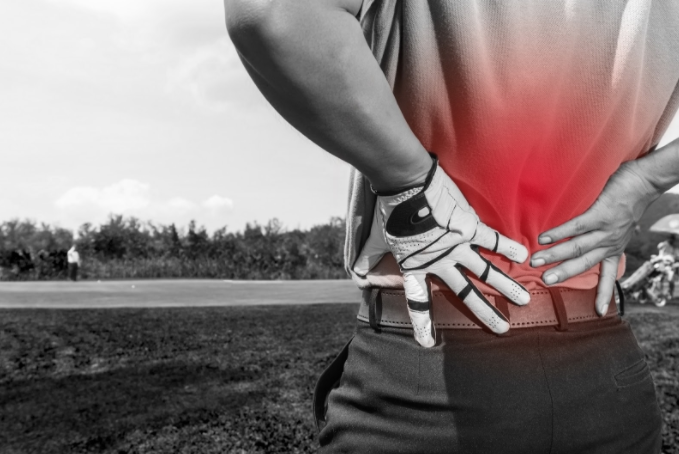
Exercise is a vital part of everyone’s life – without it, a serious toll could be taken on our health. Whether you choose to exercise through visiting the gym, walking, cycling, running, or taking part in sports, there are risks involved. Intense exercise, or exercising without warming up and cooling down properly, could hurt your health more than help it.
One of the most common areas of injury is the back. If a back injury goes ignored or untreated, it could affect how you exercise and live your life in the future, which is why it’s important to know about the different types of back injury – and how they can be treated and prevented.
The Types of Back Injury
Lower Back
The lower back is one of the primary victims of sports-related back injuries due to the amount of weight it carries – and there are multiple ways the lower back can be affected. Sports that put a repetitive impact on the lower back, such as running, sports that require the lower back to twist, such as golf, and sports that require the lower back to support an amount of weight, such as weight lifting, are all common ways for the lower back to be injured during sport.
One common lower back injury is Sciatica – caused when a torn or protruding disc in the lower back disturbs or compresses the Sciatic nerve.
Upper Back
Toward the middle and top of your spine, you are less likely to be injured due to the extra support given by your rib cage. Thought injuries involving your upper back may be less common, they can still be serious. Injuries such as rib fractures and intercostal muscle strains tend of affect this area, and are caused by sports that require the torso to rotate. Whether it’s weight training, swimming, tennis, or skiing, failure to prepare properly could lead to an upper back injury.
Neck
Neck injuries tend to occur during sports that are more contact-based, such as football – which as a result places the cervical spine at risk of injury.
Back Injuries in Young Athletes
While back injuries in young athletes aren’t overly common – and are more often than not the result of muscle strains or ligament sprains – there are some injuries that may feel similar to a sprain, but that are actually more serious.
Muscle Strains and Ligament Sprains
For most young athletes, back pain is the result of muscle strains and ligament sprains, and these are caused by repetitive overuse, improper techniques, insufficient stretching, and trauma. As these injuries aren’t too serious, treatment often involves rest, medication, and light exercises. By consulting a physiotherapist, the injured athlete can be shown the proper exercises to assist their recovery and improve their strength and flexibility in the future.
Spondylolysis and Spondylolisthesis
Spondylolysis (defects of a vertebral pars interarticularis) and spondylolisthesis (the slippage of one vertebra in relation to another vertebra) are two common causes of back pain for young athletes, and are often the result of sports that require the spine to hyperextend or to twist. The symptoms often make the injury appear to be just a sprain, but an x-ray or CT scan can confirm a more serious injury. An athlete that has developed spondylolisthesis may be able to return to their regular sporting activities after healing, but only if they have suffered 50% or less forward slippage.
How to Prevent Back Injuries
Ideally, athletes would be able to avoid back injuries completely, but we know that this isn’t always possible. Therefore, the next best thing to do is learn how to prevent injuries – and there are several ways this can be done.
- Strengthen your core. Exercises such as crunches and pilates help to strengthen the muscles that protect your spine and reduce the amount of damage caused by repetitive actions.
- Warm up properly. Warming up your muscles and stretching thoroughly before playing a sport is a key aspect of injury prevention.
- Swim more. Swimming is one of the best exercises for conditioning your core and strengthening your back muscles.
- Check your posture and technique. Poor posture and incorrect technique are two easy ways to injure yourself. In football, the majority of players sustain back injuries from ducking their heads when tackling an opponent. With proper posture and technique, this could be avoided.
- Wear the right equipment. In many sports, the recommended equipment is designed to help provide your with protection – especially in your back and neck area.
Getting Proper Treatment
If you have sustained a back injury through sport, then it is vital that your receive proper treatment for your injuries. For most back injuries, treatment will be non-surgical and will instead focus on the use of physical therapy and exercises, combined with medication, to strengthen the injured area.
A physiotherapist will also be able to provide a tailored exercise regime for rehabilitation and the prevention of future back injuries.
At Morley Physio, our physiotherapists are experts in sports-related injuries. If you’ve been injured, don’t suffer in silence. Contact Morley Physio today to see how we can help.
Contact Us
Phone: 9375 3900
Email: admin@morleyphysio.com.au
